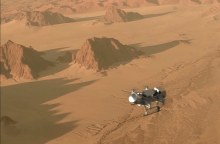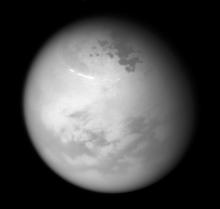Listen to today's episode of StarDate on the web the same day it airs in high-quality streaming audio without any extra ads or announcements. Choose a $8 one-month pass, or listen every day for a year for just $30.
You are here
Saturn at Opposition II
Titan, the largest moon of Saturn, is a deep freeze. Surface temperatures are close to 300 degrees below zero Fahrenheit. But Titan would be even colder without one of the components of its atmosphere: methane. The gas traps heat from the Sun, making Titan dozens of degrees warmer.
Although it makes up only a small fraction of the dense atmosphere, methane plays a critical role in shaping Titan’s surface. That’s because it acts as water does here on Earth: It forms clouds, falls as rain, and fills lakes.
Scientists aren’t sure where the methane comes from, though. Methane floats to the top of the atmosphere, where it’s destroyed by sunlight. The total supply in the atmosphere today wouldn’t last more than 10 million years. So more methane must somehow be entering the atmosphere.
There are several possible ways that could happen.
There may be deposits of methane-rich ice far below the surface. Some of the ice could make its way to the surface—perhaps through volcanoes—where it would vaporize and climb into the sky. Scientists are using observations by telescopes in space and on the ground to try to pinpoint the source of this key ingredient in Titan’s frigid atmosphere.
Bright golden Saturn is at its best for the entire year this week. It’s low in the southeast at nightfall, and remains in view all night, to the right of brighter Jupiter. Through a telescope, Titan looks like a tiny star close to the giant planet.
Script by Damond Benningfield






